This post is also available in: Italian
This exciting Sicilian itinerary runs from Catania and the foot of Mount Etna to Syracuse and Ragusa, among fragrant nurseries rich in jasmine, fragrant pelargonium and frangipani, as well as tropical and subtropical ornamental and fruit plants, succulent species, palms, cycads and many other species plants typical of mild climates. You may want to include a visit to several Sicilian gardens and the artistic and naturalistic attractions in the suggested area.
If you had more time, you should follow this itinerary right after our first recommendation: Discovering Nurseries: Messina and its outskirts (Sicilia/1).
The Nurseries
The map shows the nurseries and other locations included in our suggested itinerary. Distances are also mentioned, in order to make it easier and more practical for you to make your choice and save petrol and time.
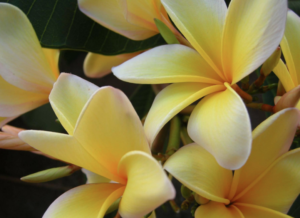
Sun Island Nursery in Catalbiano (CT): a wonderful nursery established by Pietro Petiet and his wife Laura, some twenty years ago. Pietro actually followed in his Dutch father’s footsteps; the latter – Jan Petiet, a renowned botanist and genetic engineer – had, in fact, created a wonderful collection of tropical plants in the 1970s.
Among the most striking features of this nursery, there are several Hibiscus and Bouganvillea, as well as a splendid collection of Frangipani, with both autochthonous and tropical varieties.
Sicily is, in fact, one of the very few places in Europe where you can find frangipani: originally coming from tropical America, they should have arrived in Sicily in 1810 and eventually becoming the very symbol of the city of Palermo and its wondrous botanical garden.
Distances to other nurseries: 9 miles to Faro Nursery – 10 miles to Malvarosa Nursery – 20 miles to Valverde Nursery – 67 miles to Erbavoglio – 104 miles to Vivai del Valentino – 85 miles to Sallemi Farm.
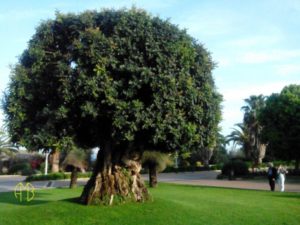
Faro Nursery, in Giarre (CT): Faro Nursery
This nursery is specialized in the production and distribution of Mediterranean, subtropical and arid climate plants. It’s a large facility established founded by Venerando Faro fifty years ago; today, it is run by his sons Mario and Michele. It produces Mediterranean and exotic plants of Mediterranean, subtropical and arid climate origins.
Piante Faro owns 1.235 acres of crops, including some 100 acres dedicated to greenhouses – it includes 15 different companies, located in Sicily and Tunisia. It cultivates more than 800 species and 5000 varieties, exported to 60 countries and often used in important projects around the world.
The collection of mother plants is absolutely wonderful, located mostly in the Giarre facility and used for reproduction purposes: it includes several members of the Cicadeae family (Cycas, Macrozamia and Enchefaloartos), tree ferns and palms.
Distances to other nurseries: 1 mile to Malvarosa Nursery – 9 miles to Sun Island Nursery – 11 miles to Valverde Nursery – 61 miles to Erbavoglio – 97 miles to Vivai del Valentino – 78 miles to Sallemi Farm.
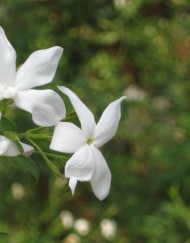
Malvarosa Nursery, in Carruba, Giarre (CT): This nursery is in Carruba, a district of Giarre (CT), set within an ancient citrus grove; it is specialized in fragrant Pelargonium and rare jasmine; the latter is arranged in a nice collection along an educational path within the premises. Visitors would be impressed by the huge number of varieties, with white, yellow and even pink flowers. Many are reserved for warm or mild climates, but other specimens are quite rustic, so they can be grown without any problems in northern areas. Filippo Figuera will tell you all about those magnificent flowers.
Jasmines are also grown in a garden, the only one in Europe entirely dedicated to the Jasminum genus and fitted with plenty of educational opportunities in order to make those wonderful plants known to the whole wide world.
Distances to other nurseries: 10 miles to Valverde Nursery – 10 miles to1.5 Sun Island Nursery – 1 mile to Faro Nursery – 61 miles to Erbavoglio – 97 miles to Vivai del Valentino – 78 miles to Sallemi Farm.
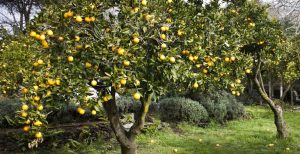
Az. agr. Vivai Valverde, in Maugeri (CT): This nursery was established almost by chance in 1987, thanks to the passion for plants of its founders, Ester Cappadonna and her husband, Francesco Borgese, an agronomist and landscape architect.
Located on the slopes of Mount Etna, this company deals almost exclusively with the reproduction of forgotten plants: namely, some rare and unusual local varieties just as strong and beautiful as the contemporary ones.
Rather than a nursery farm, Vivai Valverde looks like a private garden, dedicated to real plant lovers.
Distances to other nurseries: 50 miles to Erbavoglio – 20 miles to Sun Island Nursery – 11 miles to Faro Nursery – 10 miles to Malvarosa Nursery – 86 miles to Vivai del Valentino – 67 miles to Sallemi Farm.
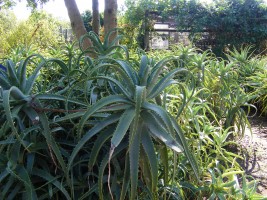
Azienda agricola Erbavoglio Rinaura, 2,5 miles from the city centre of Siracusa: some 2.5 miles from the centre of Siracusa, there’s Erbavoglio Rinaura nursery, owned by Silvana Sindona and specialized in the production of Aloe arborescens and native, aromatic and medicinal potted plants (including Onites siracusanum, Origanum pseudodictamus, Aloisia pogostemon, Artemisia annua, and Moringa oleifera), almonds and oil.
A cosy B&B is annexed to the nursery, where natural anti-stress therapies, gardening and aromatherapy courses are regularly offered to its guests. Educational walks, discovering the local flora, are also available.
Distances to other nurseries: 40 miles to Vivai del Valentino – 67 miles to Sun Island Nursery – 61 miles to Faro Nursery – 61 miles to Malvarosa Nursery – 50 miles to Valverde Nursery – 56 miles to Sallemi Farm.

Valentino Nursery, in Scicli, a district Sampieri (RG): this nursery produces succulent, Mediterranean, exotic and tropical plants, palms, Liliaceae, Agavaceae, and Cactaceae
Favoured by the sub-tropical climate of the farthest corner of south-eastern Sicily, in the province of Ragusa (behind the splendid bay of Sampierri and overlooking the sea towards Malta), this nursery successfully grows ornamental, exotic and tropical plants, Liliaceae, Agavaceae, and Cactaceae, painstakingly cultivated by Giovanni and Marina.
The 2.7-acre park-nursery also features the charming “Dimore del Valentino” farmhouse, with a swimming pool.
Distances to other nurseries: 31 miles to Sallemi Farm – 104 miles to Sun Island Nursery – 97 miles to Faro Nursery – 97 miles to Malvarosa Nursery – 86 miles to Valverde Nursery – 40 miles to Erbavoglio Nursery.
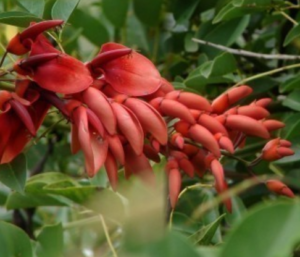
Az. Agr. Sallemi Massimo, a Vittoria (RG): specializzata nella coltivazione di palme tropicali, piante tropicali ornamentali e piante tropicali da frutto. La loro collezione è ricchissima, fra ananas, arstiolochie, baobab, banani, bahunie, babaco, erithryne, mimose, passiflora, tamarindo, thevetie, solanum,tomatillo…
Distances to other nurseries: 84.5 miles to Sun Island Nursery – 78 miles to Faro Nursery – 78 miles to Malvarosa Nursery – 67 miles to Valverde Nursery – 56,5 miles to Erbavoglio Nursery – 30,5 miles to Valentino Nursery.
Gardens along the itinerary
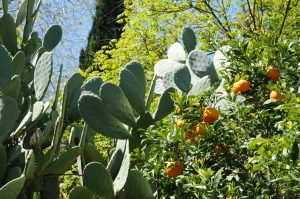
Giardino di Villa Trinità, in Mascalucia (CT): In Mascalucia, near Catania, at 1.476 ft above the sea, there’s Villa Trinità and its botanical garden. The owners, the Bonajuto family, have preserved it over time, safeguarding its very ancient features.
The villa was built in 1609, on the remains of Hellenic and Roman settlements and petrified lava flows dating back to 1382; the building takes its name from the nearby church of the Holy Trinity and was originally intended as a country estate, still retaining such typical appearance today.
Until 1800, the local main activity was the production of wine, which continued until the early 1900s: the time when the Bonajutos, coming from a wealthy aristocratic family, moved to the countryside to assist the winemakers.
In 1960, the cultivation of citrus fruits began and, from the 1980s onwards, the villa was used a permanent residence by its owners. On the second weekend of June, the garden of Villa Trinità hosts a special market exhibition of plants and furnishings for the Mediterranean gardens called “Dove fiorisce la Jacaranda”.
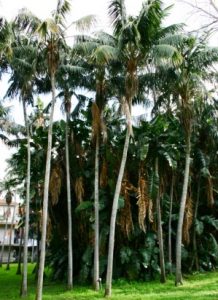
Parco delle Kenzie, in Riposto (CT): a 2.2-acre botanical garden that includes an educational museum and a greenhouse. It also features a magnificent collection of 100 specimens of Howea forsteriana, as tall as 32 ft, planted in the early XX century.
Many other beautiful gardens are listed at Discovering Gardens: North-Eastern Sicily.
Natural Reserves:
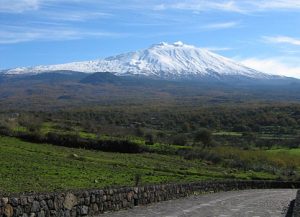
Mount Etna Regional Park, Established in 1987, the Etna Regional Park covers about 146.000 acres thousand hectares and includes 20 municipalities lying on the sides of the mountain. It can be reached by train (Circumetnea Railway), and it is divided into four different protection areas: zone A (the “integral reserve”), where nature is safeguarded as much as possible; zone B, which integrates some economic activities (featuring peasant houses with small agricultural plots); areas C and D, which benefit from “controlled development protection”, merging economic exploitation with thorough respect for the environment and the landscape.
The territory is crisscrossed by a thick network of naturalistic, scientific and cultural paths. Its volcanic origin has given rise to a well-characterized and particular plant microcosm. The most exciting excursion is undoubtedly the ascent to the craters on the top of the volcano, going through woods, evocative valleys and, finally, the lunar landscape that reaches the height of 9.842 with the whole of Sicily below.

Vendicari Reserve , is located in the province of Siracusa, between Noto and Marzamemi. Officially established in 1984 but opened only in 1989, it now covers 3.583 acres of “wetland of international importance”, according to the 1971 Ramsar Convention; it is currently managed by the Regional State Forestry Company.
The Vendicari Reserve covers about 3.736 acres, 2.315 of which constitute the “pre-reserve” area, dedicated to agriculture (citrus and olive groves, vineyards and vegetable gardens).
It includes archaeological and architectural settlements dating back even to the first Greek inhabitants, traces of storage tanks of a Roman fish processing facility, a small necropolis, and a Swabian tower, built at the end of the XIV century. There is also a “tonnara” (“tuna fishery”), several canals connected to the sea, and other installations for processing seafood – they remained active until the mid-XX century.
Accommodation

Etna Botanic Garden-Villa Trinità, in Mascalucia (CT). Villa Trinità includes a delightful farmhouse inside the Etna Botanic Garden, which offers two bedrooms and six apartments.
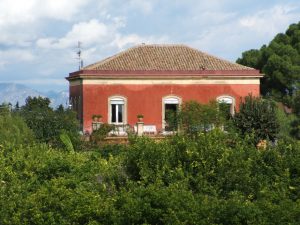
B&B Vivaio Malvarosa, in Carruba, Giarre (CT): the quaint farmhouse next to the nursery offers B&B accommodation, as well as fresh food and local produce including jams, preserves, chocolate treats and Jasmin/Hollyhock -based cosmetic products.
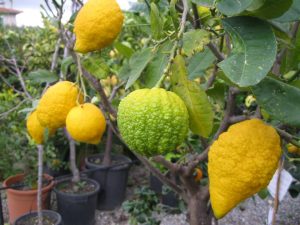
B&B Hortus Herperidis, a Mazzara Sant’Andrea (ME): this nice B&B facility is annexed to the nursery specialized in citrus fruits, olives and Mediterranean plant species.
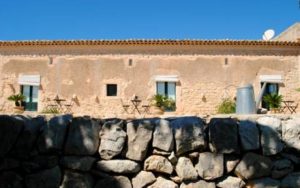
Dimore del Valentino, a Scicli (RG): this exquisite farm stay facility is annexed to the nursery in the enchanted Val Di Noto. The city of Scicli – recently acknowledged as a UNESCO World Heritage Site – is quite near, as well as a true wealth of artistic and natural attractions.

B&B Erbavoglio, not far from Siracusa city centre: a cosy B&B is annexed to the nursery, where natural anti-stress therapies, gardening and aromatherapy courses are regularly offered to its guests. Educational walks, discovering the local flora, are also available.
What to buy:
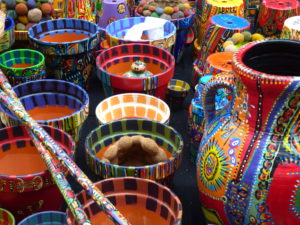
Alessandra Intelisano’s Vases: A true Sicilian, Alessandra Intelisano creates ceramic vases, baskets, chairs and furniture, of various shapes and sizes; her creations are hand-painted and inspired by African colours and patterns, which she brings to life with her own cheerful and jazzy style. Each piece is unique and one of its kind.
I pistacchi di Bronte, the P.D.O. “Pistachio Verde di Bronte” relates to the Pistacia vera species (“Napoletana” cultivar, also called “Bianca” or “Nostrale”), grafted on Pistacia terebinthus. Then, there’s Zafferana Etnea Honey, Maletto Strawberries, the mushrooms from Nicolosi and Nerello, as well as the D.O.C. wine from Mount Etna.
This post is also available in: Italian


Leave a Reply